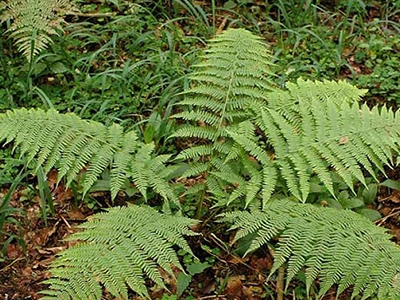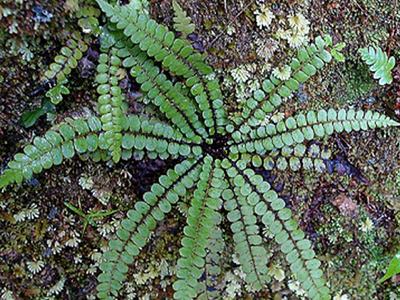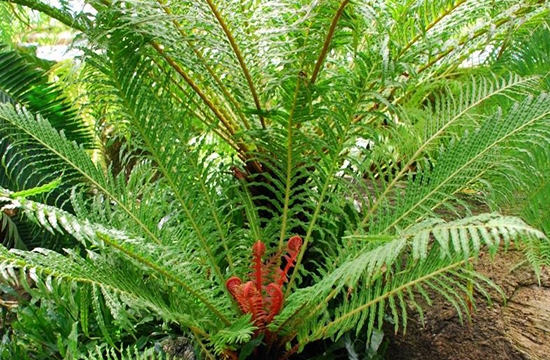
Blechnum, derbyanka (Blechnum) is a perennial fern that forms beautiful spreading bushes of bright green color. They can decorate both a flower bed and a window sill or a winter garden. The plant has a rather difficult character, demanding care, so in order to grow it at home, you need to know a few simple rules. In return, the fern will please the eye with rapid development and violent growth.
Belongs to the family Derbyankovye . Numerous genus blehnum has about 200 plant species.

Gardening professionals sometimes also call this plant “derbyanka”. The fern is quite widespread in western Europe, eastern Asia, and North America. It is believed that the birthplace of the plant is South Africa.
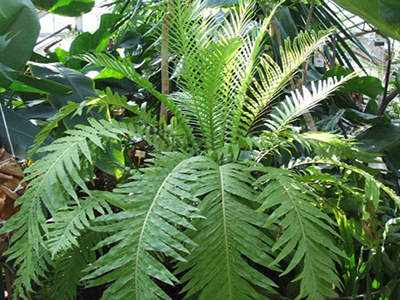
An evergreen ornamental tree fern that looks like a palm tree. In nature, it grows up to 3 m, in rooms – no more than 0.5-0.7 m.
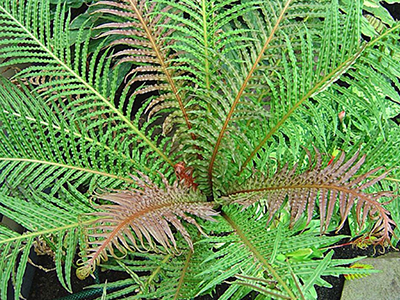
The plant has a short dense stem, which is covered with thick leaves. The leaves are pinnately cut, light green, leathery. Over time, the stem becomes ossified and acquires a light brown color. The stem of the plant is transformed into a root system, which extends over the entire surface of the soil and takes part in the process of creating a peat layer.
Blehnum silver lady (V. silver lady), spiky and other types of derby
In room conditions, the following types of blechnum are most often grown: B. silver lady (V. silver lady),
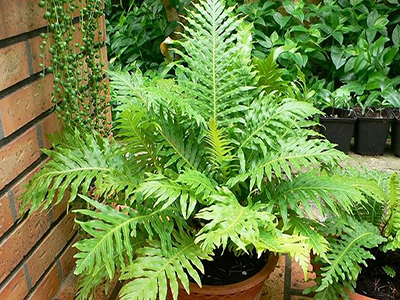
B. Brazilian (V. brasiliense),

B. humpbacked (V. gibbum),

B. Indian (B. indicum),

B. spiked (V. spicant),

B. Japanese or Nipponian (B. nipponicum),
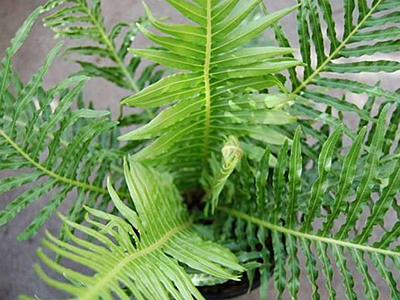
B. river (B. fluviatile),

B. cirro-marine (B. penna-marina).

Blechnum brazilian stands out with an olive tint of shoots on fairly wide leaves. Fern creates a spreading, but not very tall bush. The young leaves are orange-pink in color and form into a small rosette in the middle of the plant, which adds to its attractiveness.
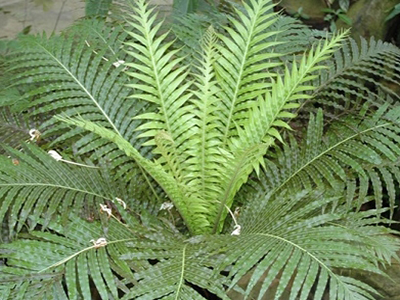
Blehnum silver lady is a fern, with pronounced silvery leaves, with lanceolate, narrowed lobes. Spreading bushes of the plant reach a diameter of up to 60 cm.

Blehnum humpbacked is considered one of the most famous species, it grows up to 60 cm high. The leaves are colored light green, with almost no petioles, they sit densely on a short trunk. The leaves are oblong, broader at the beginning, and pointed closer to the edge. The scope of the frond reaches 40-60 cm.
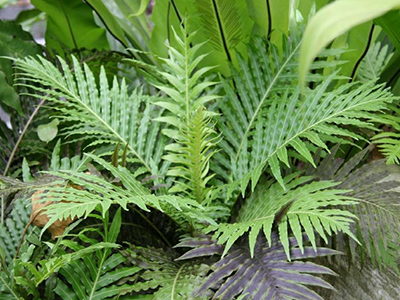
A variety of derby called Indian can be recognized by an elegant branched root system, a thick stem, on which glossy leaves are localized. The maximum height of the plant reaches almost 50 cm.

Derbyanka spiky is a fairly compact bush that loves warmth and does not tolerate drafts. It has narrow, glossy leaves, dark green or light green in color with black petioles. It has a rather short stature, about 30 cm.

Japanese Blechnum is a cold-resistant fern of a fairly small size, no more than 40 cm, which has narrow green leaves.

Derbyanka river has a spherical crown and oval leaf plates. The height of the plant is about 35 cm, the leaf span reaches 40 cm.

Cirro-marine blechnum reaches a height of no more than 15 cm. It is a dense, very compact fern that requires frequent division, as it spreads very widely over the surface of the earth. Has deep green leaves
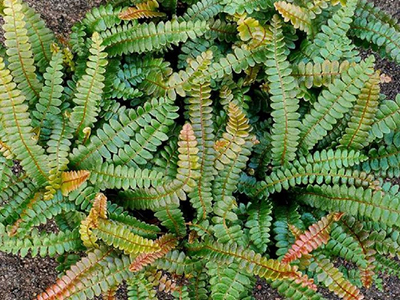
.
Care and reproduction of blechnum at home
In order to grow blechnum at home, you need to ensure proper care of the bush. Blechnum is a photophilous plant, but does not tolerate direct sun. The temperature in winter is 8-16 ° C, in summer it is not higher than + 25 ° C, otherwise the leaves will begin to dry and stop growing. The place where the fern grows should be quiet, without drafts.
Does not need to be sprayed, this can lead to the fact that the leaves begin to deteriorate. It is necessary to maintain high humidity. Blehnum categorically does not tolerate very cold window sills, sudden temperature changes, hot air from batteries and air conditioners.
Transplantation is done as needed, when the root system completely covers the pot, it is advisable to carry out the procedure in early spring (March – April). The optimal substrate is clay-turf and leafy soil, peat, humus, sand (1: 1: 1.5: 1: 0.5). The soil should be light, with low or neutral acidity.
During the entire growing season, monthly, in winter once every 2 months, top dressing is carried out. The fern is usually fed with mineral fertilizers, which are intended for non-flowering plants. If the bush has a healthy appearance, you do not need to make a lot of fertilizer, half the serving will be enough. From its overabundance, the fern will start to hurt. Blehnum rarely succumbs to diseases or attacks of various types of pests.
Problems in caring for blechnum can be associated with incorrect fern content. He needs to ensure regular watering with water without lime, plentiful in summer. Water for irrigation must be of high quality. If there is no way to filter it, then you need to at least defend it. It should be slightly warm and without chlorine impurities. Poor quality water can cause rot on the roots, and even the death of the plant itself.
Neither overmoistening nor overdrying of the soil should be allowed. If the room is too hot, then brown spots begin to appear on the leaves. Under the influence of too dry air, the leaves turn yellow, and the bush practically does not grow. The fern loves fresh air very much, so it needs regular airing. Yellow leaves may also indicate a lack of fertilizer.
Sometimes the lower, middle-aged fern leaves drop and dry, which spoils the appearance of the plant. They do not fall off by themselves, so the plant needs systematic pruning. The leaves are cut as low as possible at the base of the stem so that no stumps remain.
Derbyanka reproduces quite successfully by root shoots and spores. The most simple way is the propagation of ferns by root shoots. To do this, in the spring they dig up an adult plant and cut its root in half. The place of cuts is treated with crushed charcoal and buried in the ground. New shoots should appear in a few weeks.
Flower growers with experience effortlessly propagate the fern with spores. To do this, a large sheet is cut off and the spores are carefully scraped into the container. At the beginning of spring, the resulting material is sown in a tray with prepared soil, which is placed on a warm surface. The soil before sowing must be warmed up and disinfected. It is important not to forget to constantly moisten the ground so that the humidity is maintained longer, the container is covered with a transparent film or glass. Every day, the shelter must be removed for 30 minutes.
For about three months, or maybe a little less, when the bloom is in the germination period, the nursery should be placed in a dark place. When the first shoots appear, the seedlings must be thinned out, the distance between them should be no less than 3 cm. After 30 days, young ferns are transplanted into pots with a prepared substrate. Containers with plants are best placed on stands to avoid hypothermia.
See what the blehnum flower looks like in the photo.

